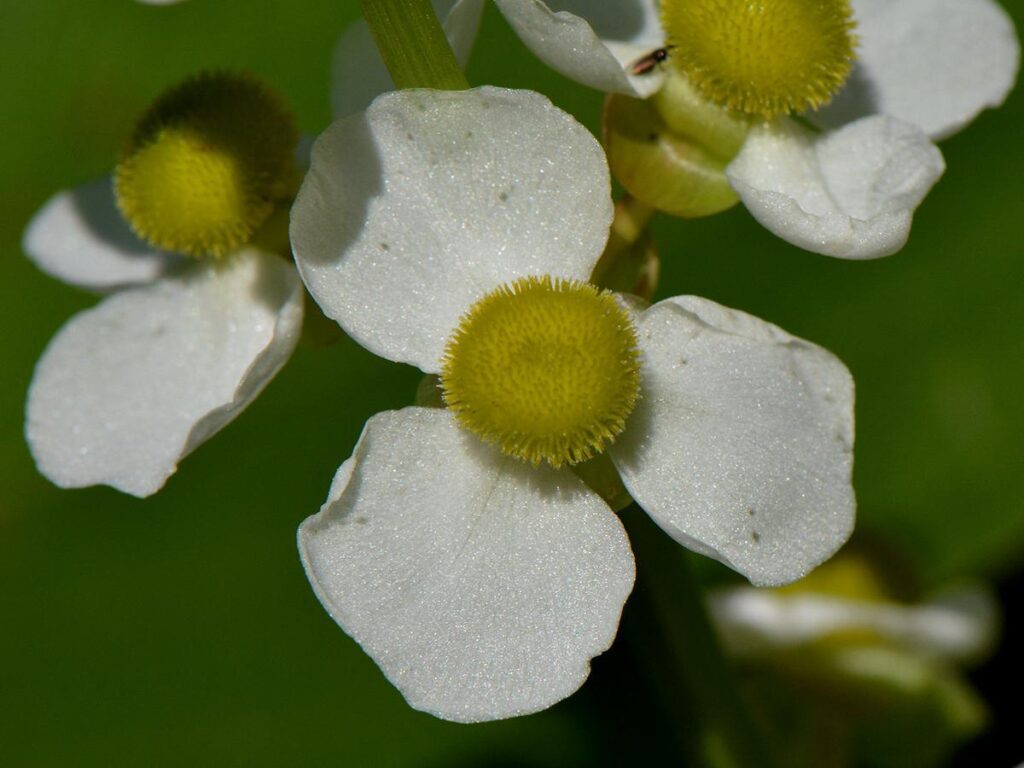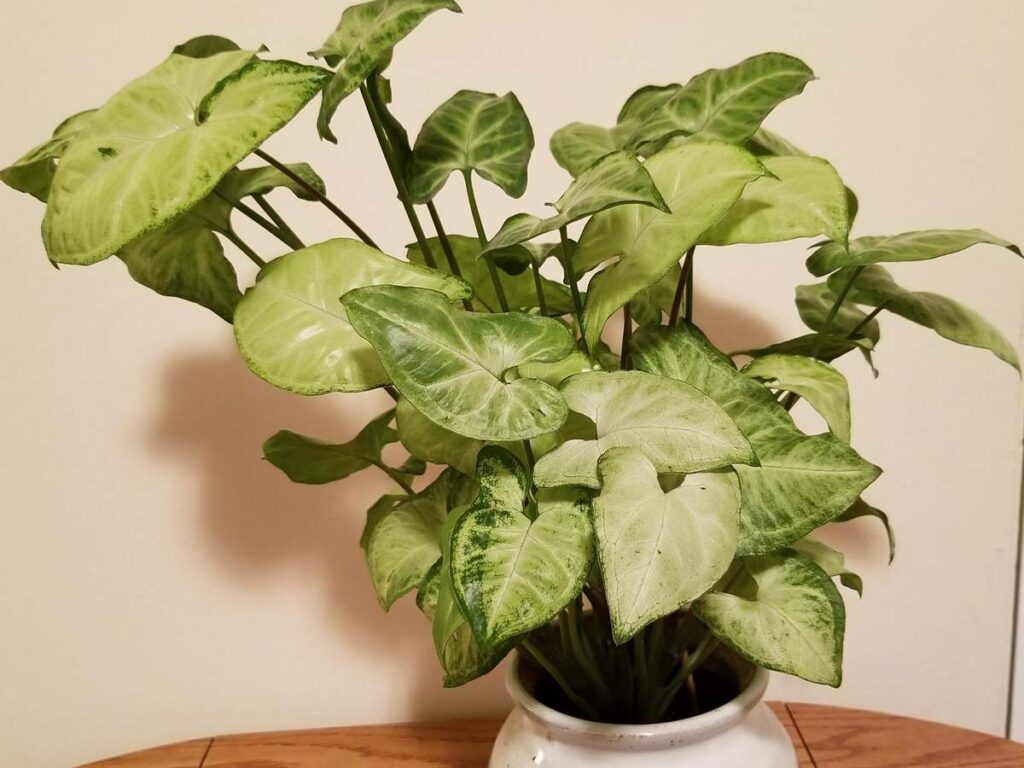In the plant world, there are many unique and interesting species that can be found. One such plant is the Arrowhead plant (Syngonium podophyllum).
This tropical evergreen vine is native to Central and South America and gets its name from the shape of its leaves, which resemble arrows.
Arrowhead plants can be grown both indoors and outdoors and make for beautiful additions to any home or garden.
But do they really have flowers? And if they do, how do you get them to bloom?
In this article, I’ll tell you everything you need to know about Arrowhead plants, including whether they have flowers, how to get them to bloom, and how to care for them.
Does the Arrowhead Plant Have Flowers?
The Arrowhead plant has flowers even though it rarely blooms. These flowers are typically white or green in color, and they grow in clusters on the plant. The flowers are relatively small, but they are quite pretty and add a nice touch of color to the plant.

What Are the Arrowhead Plant’s Flowers Like?
The Arrowhead Plant’s flowers are white with three rounded petals. The inflorescence has whorls of three flowers and is borne above the water’s surface. The flowers have separate sexes and are monoecious.
Female Arrowhead flowers have rounded green centers, while male flowers have dense clusters of yellow stamens. These tiny flowers are arranged in two to eight whorls at the top of 20 to 50 cm-long flower scapes. The inflorescence’s bracts are 5–10 mm in length, and they’re either blunt or rounded at the end. A single to two centimeters in length.
The spike-shaped blossoms of the Arrowhead plant range in color from green to a blueish white. A spathe, a kind of sheathing bract that is green and white, surrounds them. Blossom clusters appear in the axils of leaves.
There are three white petals and a group of yellow stamens in each flower, which are responsible for holding pollen.
In their native environments, Arrowhead plants are typically located near water. White, three-whorled flowers float above the water.
When Do Arrowhead Plants Flower?
The Arrowhead plant blooms from mid- to late-summer to early fall, from July to September, when it is grown in nature and has had time to mature. If you keep it indoors, you probably won’t see blooms. An Arrowhead plant that has been pruned will not produce flowers.
The Arrowhead plant’s flowers can reach up to 45ºC, even when the air temperature is lower.
What Types of Flowers Does the Arrowhead Plant Have?
The Arrowhead plant’s flower is a white flower that sits above the water’s surface. It is available in a variety of cultivars with different leaf sizes and colors, as well as different accents on the leaves.
“White Butterfly” is a cultivar of Arrowhead plants and is available in eight-inch pots at Terrain. Other common cultivars include ‘Pink Fairy’ and ‘Golden Allusion.’
The Arrowhead plant flower is a beautiful, brightly colored flower that can vary in size and shape. The leaves of Arrowhead plants can be a variety of colors, and the plants can grow to be very tall.
Some of the best Arrowhead plant cultivars have glossy leaves that start out salmon pink before fading to medium green.
How Often Does an Arrowhead Plant Flower?
You may think that Arrowhead plants only flower once every year, but that isn’t true at all. You’ll find that Arrowhead plants actually flower multiple times throughout the growing season. However, if you leave them unpruned, they won’t bloom until springtime.
To encourage flowering, you should prune your Arrowhead plant regularly. Pruning helps keep the plant healthy and encourages blooms. As long as you cut back your Arrowhead plants often enough, they will keep making flowers for the whole growing season.
Your Arrowhead plant needs to be pruned at least twice per month during its growth cycle. During the winter months, you should trim off any dead leaves and branches. Then, in early spring, you should remove any remaining foliage. Finally, in late summer, you should cut away any remaining stems.
Keep your Arrowhead plant well watered and fertilized to encourage flowering. Fertilize your Arrowhead plant with a slow-release fertilizer that promotes root development. Water your Arrowhead plant thoroughly after applying the fertilizer.
Where Do Arrowhead Flowers Grow?
Arrowhead plants are native to North America. They prefer wetlands adjacent to the receding shorelines of small ponds and creeks. These wetlands are ideal growing conditions because they provide water and nutrients for the plants.
Arrowhead flowers are unique because they lack the typical Arrowhead-shape blade found on most other types of plants. Instead, they have grass-like leaves. This characteristic makes them stand out among other plants because it shows that they adapt to changing environments.
Their leaves lack the typical arrow head shape and are instead grassy, which demonstrates how the surrounding environment affects the plant.
How Do You Get the Arrowhead Plant to Bloom?
The Arrowhead plant rarely blooms indoors. However, there are still exceptions. To get an Arrowhead plant to bloom, one must water it regularly and fertilize it with an all-purpose plant food monthly. It is possible to propagate Arrowhead plants from seed, but this is not the preferred method.
How to Take Care of an Arrowhead Plant?
Arrowhead plants are easy to care for once established. All you really need to do is water regularly and fertilize occasionally. Once the plants have been planted, you should wait until springtime to give them light.
During the winter months, keep the soil moist but not soggy. Don’t let the pots sit in standing water. After the plants have sprouted, you can move them outside during warm weather. Make sure to bring them inside again when temperatures drop below freezing.
Arrowhead plants like bright sunlight, so try to position them near windows. Keep the soil around the roots moist, but avoid standing water. Arrowhead plants prefer cool temperatures, so you may want to consider moving them indoors during hot summer days.
The best part of growing your own flowers is that you can enjoy them year-round!
If you’re ready to take your gardening skills to the next level, check out these tips for starting to grow an Arrowhead plant indoors.

Step 1: Choose the right pot
An Arrowhead plant needs to be taken care of properly if you want it to grow well. You’ll want to choose the right pot and potting medium for the plant. Then, you’ll want to water the plant until the excess moisture drains out of the drainage hole.
You may not realize it, but there are several types of pots available for plants. Some pots are made specifically for growing plants, while others are used for decorative purposes only. Choose the right pot for your Arrowhead plant, and keep it watered until the excess water drains out of the drainage holes.
Step 2: Place the pot in the right location
The Arrowhead plant’s pot should be placed in a bright spot with indirect sunlight.
The Arrowhead plant should be placed in a pot near the top of its stem to maximize growth.
The three options for where to place the Arrowhead plant’s pot are: near the top of the stem; in a bright spot with indirect sunlight; or in a spot with direct sunlight. Each choice has its own pros and cons that you should think about before making one.
Near the top of the stem, the plant will be able to receive more light, but it may also be more exposed to wind and other elements.
In a bright spot with indirect sunlight, the plant will be protected from some elements but may not receive as much light.
In a spot with direct sunlight, the plant will receive plenty of light but may also be at risk of overheating.
Step 3: Water the plant
The Arrowhead plant should be watered every 2–5 days during the summer and only in the winter months if it is dormant. Water with a spray bottle or mist to keep the foliage moist, and place the pot on a tray of pebbles to increase humidity. Arrowhead plants can get bacterial leaf spots if the leaves stay wet for a long time, so water them less often if the leaves stay wet for a long time.
Step 4: Fertilize the plant
It is important to fertilize an Arrowhead plant in the spring and summer months to help it grow. Feeding the plant regularly with a liquid fertilizer during these months will give it the nutrients it needs to thrive.
Fertilizing an Arrowhead plant in the winter is not necessary because the plant is dormant during this time, and fertilizing would not help it grow any faster.
Step 5: Prune the plant
Pruning is necessary to keep the plant compact and encourage its Arrowhead-shaped leaves. Cutting off the plant’s new stems as they grow makes it less likely to make vines and climb. Pruning encourages new growth, which makes the plant bushier.
Step 6: Repot the plant
It is necessary to repot an Arrowhead plant when the crown of the plant is not at the same height as it was in its original container. This can happen when the roots have become crowded and need more room to grow.
Repotting also allows for fresh potting soil to be added, which can provide nutrients for the plant.
The best time to report an Arrowhead plant is in the late fall or early winter, when the plant is dormant.
Should You Cut the Flowers Off Your Arrowhead Plant?
The purpose of flowers on an Arrowhead plant is to encourage new growth and make the plant bushier. Flowers should be removed if the plant is being grown for its Arrowhead-shaped leaves. Cuttings can be taken from the plant to grow new plants.
Arrowhead plants are known for their beautiful, Arrowhead-shaped leaves. However, sometimes the plant grows so tall that the flower stems become very long. You may not want to cut off the flower stems, but you’ll want to keep them trimmed down to prevent the plant from becoming unruly.
You can trim the flower stems yourself using scissors or pruning shears. Just remember to remove any buds that form at the base of the stem. These buds will grow into new flowers later on.
Keep the flower stems trimmed to avoid making the plant unruly. Remove any buds that form at their base.
Source:
Arrowhead (Sagittaria cuneata)









